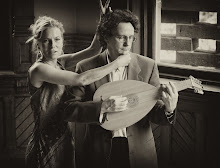

Besard, as I say, recommends the new hand position, 'execpt thy thombe be short.' Well, mine is very short, and I think the old technique works better for the older pieces in the book. The piece you can listen to above or download here, for instance, is by Alfonso Ferrabosco the Elder, who died in 1588. I think that the older technique favours the polyphonic nature of most of the works in the book, but that the corantos (actually new French style courantes) in the end of the book are better with the thumb outside. The older technique makes it easier to bring out the polyphony and the new technique brings out the treble and bass, which is more polarised and uses 'style brisé' decoration, rather than 'divisions'.
So what technique do you use for the music of John Dowland, who contributes to the book tips for how to buy strings and how to tie your frets on in the right place? (The placements come out as just about equal temperament.) There are more pieces by John Dowland than any other composer in the book. I usually play them with my thumb inside in the old manner, but he lived in a period of transition. Saying 'this is a recording of John Dowland's complete lute works with original instruments and authentic playing techniques' is impossible. In addition to the changing technique and his lute going from having six to nine or ten pairs of strings in his lifetime, there are usually several versions of his pieces.
The type of dance you hear above, the pavan, is a slow dance which is almost like a processional onto the dance floor. There are usually three sections, or 'strains' they would say, each of which are repeated. You can hear Ferrabosco's written out decorations, they would say 'divisions' in the repeats of the strains. Alfonso Ferrabosco the Elder is the composer of the piece that the crazy lord can't get out of his head in Rose Tremain's book Music and Silence which was very popular a few years ago.


